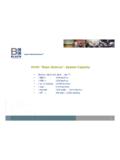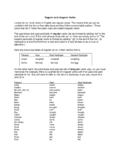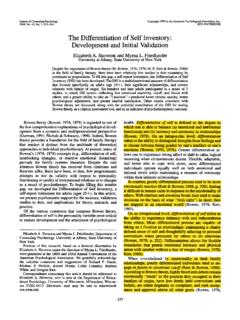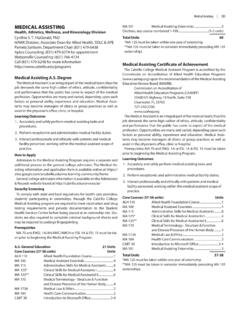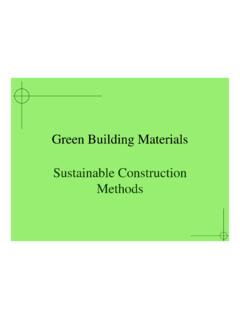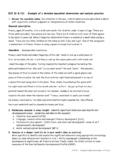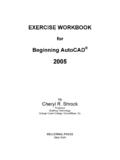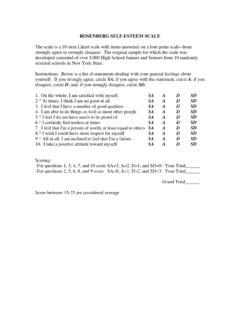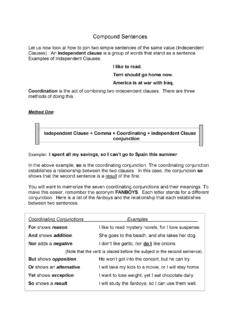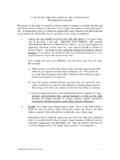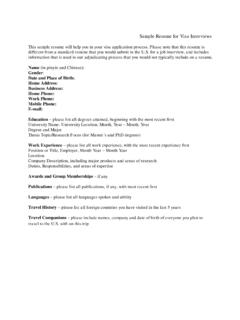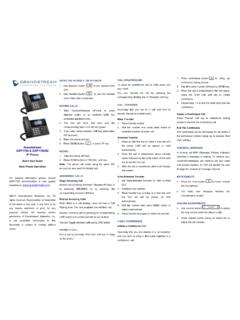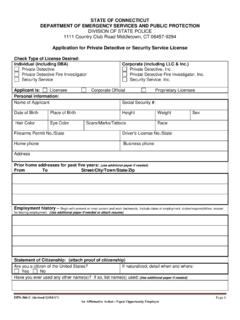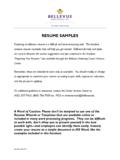Transcription of RESUMES COVER LETTERS - Breakthroughs Happen …
1 RESUMES & COVER LETTERS A guideline written by Lyn Hood Student Employment Coordinator Cabrillo College TABLE OF CONTENTS Page Number Topic 1 General Pointers, Your Employment History 2 Chronological, Functional & Combined Format Styles Described 3 Other Formats, How To Put Your Background Into The Chronological Or Functional Formats, Headings, Objective Statement 4 Academic Background, Other Skill Headings, References 5 LETTERS Of Recommendation, What Not To Include 6 Key Words 7 Sample Phrases 8 Description Of COVER letter 9 COVER letter Format 10 Sample COVER letter Sections 11 Print And Internet Resources 12-14 Chronological RESUMES Examples 15-18 Functional (Combined Format) RESUMES Examples 20 Skills/Abilities resume Example 21-24 Mixed Format resume Examples 25 Scannable resume Example 26 References Sample 27 What NOT To Do In A resume (Sample) 28 Follow-Up Correspondence 29 Scannable RESUMES (How To), Posting On-Line 30 Web RESUMES , E-Mailing RESUMES , Final Tips 10/03 word/handouts/resumebook-a/doc RESUMES A resume is one of the most important tools of job seeking.
2 The resume and the COVER letter are what get you in the door to the employment interview. RESUMES can also be used as an effective networking tool. Provide copies to friends and colleagues and let them know what type of work you are seeking. SOME GENERAL POINTERS: 1. The resume should be as short as possible, the longer the resume , the less important the person. Like being set up on a blind date, it should make them want to meet you, but does not disappoint them when you show up. 2. Tailor your resume to a particular field or industry. If you are interested in more than one area of work, you will probably need more than one resume . 3. Use action words, not weak words: action weak planned, selected, was involved in, helped supervised, designed assisted, worked under, budgeted, edited, was given responsibility for, established, directed directed 4. Give the results your work produced: a. Numbers: increasing members, sales, circulation, etc.
3 B. Time saved: how quickly you solved the problem, how much faster the work can be performed. c. Effects: the long and short-term positive effects of your work. d. Durability: how long a suggestion, idea, solution of yours has been in use. e. Expansion: your idea(s) was used in another department or become part of another project. f. Did you write any promotional or educational material, handbooks, pamphlets, flyers, g. Did you maintain contact with, or coordinate with other organizations? If so, which ones and why? 5. If your past work history consists mostly of homemaker or volunteer activities, list the duties and responsibilities of these positions as if they were paid positions. YOUR EMPLOYMENT HISTORY Now is the time to brainstorm (a free flow of information without negative censorship). Write down everything you did or had responsibility for on each job you have held. You may find it helpful to select one job a day and concentrate on that.
4 Discussing your past employment with friends or co-workers may also be enlightening. Once you have written down all the information you can remember, cross out those duties or responsibilities that fit either of the following criteria: 1. It is something that you never want to do again, and/or 2. It is completely irrelevant to the type of work for which you are targeting in this resume . 1 Circle those duties or responsibilities that you feel are the most important. Underline those responsibilities which have a lesser importance but which you feel are still important to include. To organize your thoughts, for each job you have ever held, write down all the pertinent information that you can remember about the position. List the employer, address, dates of employment, supervisors name, promotions you received, responsibilities of your position, things you created, losses you prevented, what you liked most and least about the job. Did you ever COVER for another position with different responsibilities?
5 Did you make or implement any procedural changes? Do the same thing for any education or training you have received. Did you get academic honors (usually a GPA of over ) Win awards? Get training in a specific skill or technical area? These notes will help you to provide content and determine the style of resume you will choose to produce. THE CHRONOLOGICAL FORMAT The chronological resume works best for those individuals who are looking for the same type of employment that they have held in the past. If your work history has been a series of well-defined, clearly understood jobs such as: teacher, accountant, firefighter, insurance agent, etc., then the chronological or conventional resume format may be the best method to present your skills. This format is straight forward and lends itself to concise writing. If done properly, it comes off as strong, believable, and persuasive. This format lists your work history in a chronological order.
6 Your most current position would be listed first, with your past positions listed after, in descending order through time. Generally your work history on a resume will not exceed ten years, unless you have spent an extended time in a particular position, or you have pertinent work history that extends past that time period. If your dates of employment in a job are for less than one year in one or more jobs, you may want to consider a format style that does not list the dates on the left hand margin. THE FUNCTIONAL / SKILLS FORMAT The functional or skills format resume works best for individuals who are career changers and are either combining skills from several past jobs into a new career, or who have undergone recent re-training or education to give them new job skills. The functional resume stresses strengths and accomplishments rather than presenting a chronological work history. It is called functional as it is organized under the heading of skills or functions, rather than by time block, job titles or companies.
7 This format is a good one for people who have erratic work histories or who have been employed in widely varied types of employment. (Warning: RESUMES that do not include some reference to employment dates are generally not well received by employers) THE COMBINED FORMAT This format includes both the functional/skills format, followed by a brief chronological employment history, which includes previous job titles, employer names, and dates of employment. The combined format includes the best of both worlds for many job seekers. It allows you to highlight your skills and still gives past employers an idea of your past work history. 2 OTHER FORMATS There is no one best way to write a resume . The format styles listed previously are the most common, but your background and experience, combined with the type of position you are applying for will dictate the style most appropriate for you to use. If you are seeking work in more that one type of employment, you will probably need more than one type of resume , and may use a different style of format for each one.
8 Most important is that your resume should reflect you, and be an exemplary sample of the type of work that you can produce. An on line resource that can help you decide what type of resume best fits your experience and the type of employment you are seeking is the resume CALCULATOR. In 3 minutes or less this unique online application will determine what kind of resume offers you the most powerful way to link your skills and experience to future employers. IF YOU HAVE DECIDED TO USE A CHRONOLOGICAL FORMAT Under each job title (most current first), list the skills and duties that you feel were the most important to that position, or to the position you are now seeking. These duties would be followed by duties not as important, as space permits. Try to save at least one strong accomplishment or responsibility with which to end each area. IF YOU HAVE DECIDED TO USE A FUNCTIONAL FORMAT Select three to five main headings or skill areas that are the most important to the type of work for which the resume is targeted.
9 For example, if you are looking for work in the field of Personnel your main areas might include: Recruiting, Selection, Affirmative Action, Training, and Compliance. Color code each of these main areas with a different colored highlighter pen, and then review your past work history and color code your strong points throughout your previous employment in colors that relate to your main skill areas. List these by area, in order of importance, saving something strong for an ending. An excellent reference for functional format RESUMES is Yana Parker s The resume Catalog, 200 Damn Good Examples. This reference offers examples of RESUMES geared toward a variety of types of employment, and demonstrates a variety of applicable categories to use for skill headings. NAME, ADDRESS AND PHONE NUMBER(S), EMAIL Your name address and phone number should be listed at the top of your resume . You may use the name you prefer to be called rather than your legal name if you wish.
10 Use a local address where possible, or note that you are willing to relocate. A home phone and a message phone should be listed if your home phone is not on an answering machine, or if your message machine is used by a number of household members. During your job search, be sure that the message on your phone answering machine sounds professional. The call you miss may be a job offer. Your email address should also sound professional. CAREER (JOB) OBJECTIVE A career or job objective is the first heading on your resume after your name, address and phone number. An objective should be brief, and indicate the type of employment or specific job title of the position you are seeking. A generic objective statement may be worse than none at all. Employers want to know that you are focused and are applying for the type of position they are offering. They generally do not have time to read 3 your resume and try to determine if they have a position that would work for you.
